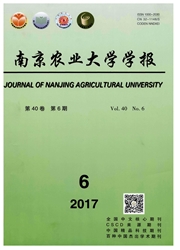

 中文摘要:
中文摘要:
通过体外培养研究了3窝(A、B、C)二花脸猪的粪样微生物对大豆黄酮的降解和雌马酚的产生规律。每窝各含1头母猪和3头仔猪。通过HPLC测定培养液中大豆黄酮和雌马酚的含量,并通过变性梯度凝胶电泳(DGGE)图谱分析每窝猪粪样微生物的变化规律。结果表明12头猪中有8头猪的粪样微生物可将大豆黄酮降解成雌马酚。其中A窝母猪粪样微生物不能代谢大豆黄酮,但在断奶后的2头仔猪粪样培养液中检测到雌马酚;B窝和C窝母猪粪样培养液中均检测到较高含量的雌马酚,在B窝1头仔猪和C窝3头仔猪粪样培养液中均检测到雌马酚。通过DGGE指纹图谱分析,每窝猪粪样培养液中可检测到雌马酚的猪粪样细菌菌群之间的相似性均大于60%,高于它们与未检测到雌马酚的猪粪样菌群的相似性。
 英文摘要:
英文摘要:
The possibility of conversation of daidzein to equol by fecal microflora of Erhualian pigs was investigated by in vitro culture with fecal sample as inoculum. Faecal samples of three litters (A, B, C) of Erhualian pigs, each litter with the sow and three piglets, were collected. Samples were used to inoculate culture bottles with and without daidzein. After 48 h incubation, the cuhures were taken to measure equol and daidzein concentrations by HPLC, and to analyze the microflora by PCR/DGGE (denaturring gradient gel electrophoresis). Results showed that microflora of eight pigs from the total 12 pigs could transform daidzein into equol. For litter A, microflora of two piglets could metabolize daidzein to pruduce equol. For litter B, microflora of sow and one piglet could metabolize daidzein to produce equol. For litter C, microflora of sow and all the piglets could metabolize daidzein to produce equol. DGGE profiles revealed that in each litter, the pigs that could transform daidzein to equol showed higher similarities, while they had lower similarities to those that did not produce equol.
 同期刊论文项目
同期刊论文项目
 同项目期刊论文
同项目期刊论文
 期刊信息
期刊信息
